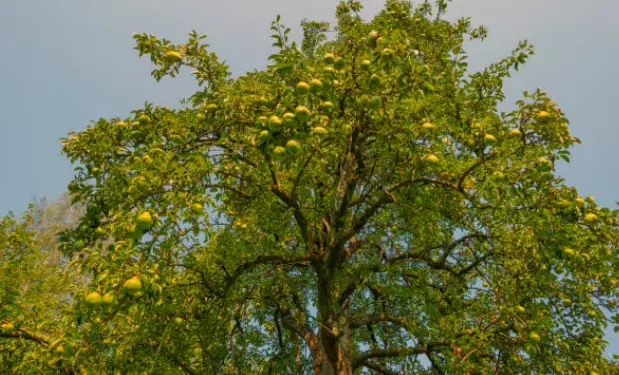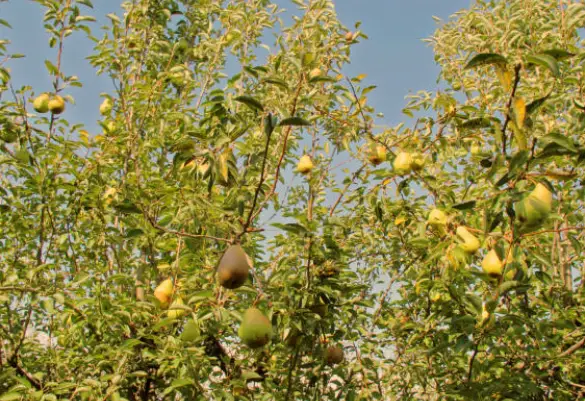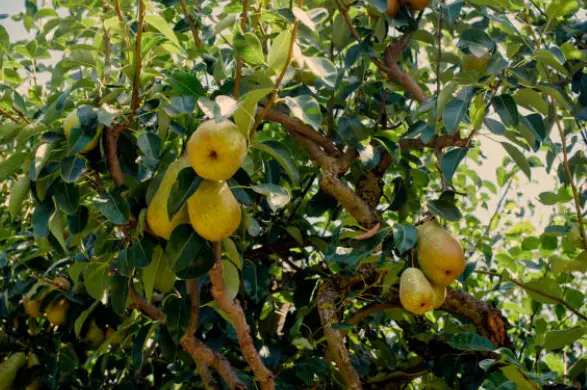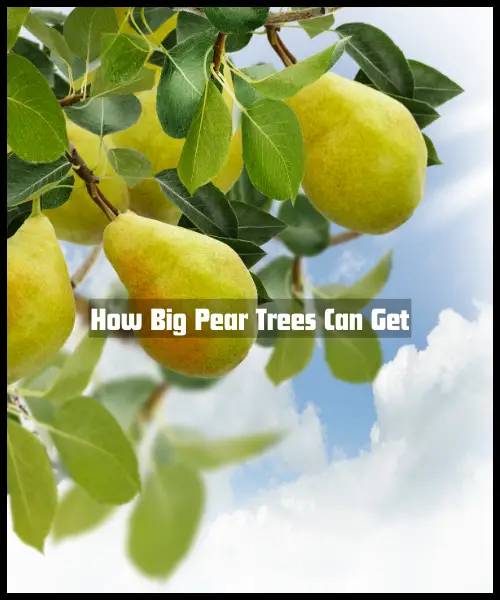Pear trees are a beloved addition to many home orchards and landscapes. With their lush foliage, spring blooms, and bountiful harvests of sweet, juicy pears, it’s no wonder these trees have captured the hearts of gardeners and fruit lovers alike.
However, one question often arises: just how big do pear trees get? The answer may surprise you, as the size of these trees can vary greatly depending on the cultivar and growing conditions.
We will go into the realm of pear tree dimensions in this extensive blog post, examining the variables that affect their growth and giving you a better idea of what to anticipate from these amazing plants.

Pear Tree Varieties and Their Sizes
The size a pear tree can reach is largely determined by its variety or cultivar. Here are some common pear cultivars and their typical mature heights and spreads:
1. Dwarf Pear Trees:
Eureka: 8–10 feet tall, 6–8 feet wide
Kieffer: 10–12 feet tall, 8–10 feet wide
Moonglow: 8–10 feet tall, 6–8 feet wide
2. Semi-Dwarf Pear Trees:
Bartlett: 12–15 feet tall, 10–12 feet wide
Comice: 15–18 feet tall, 12–15 feet wide
Seckel: 12–15 feet tall, 10–12 feet wide
3. Standard or Full-Size Pear Trees:
Anjou: 20–25 feet tall, 15-20 feet wide
Bosc: 25–30 feet tall, 20–25 feet wide
Starkrimson: 20–25 feet tall, 15-20 feet wide

As you can see, the size range for pear trees is quite extensive, with dwarf varieties staying relatively small and manageable, while standard or full-size trees can grow into towering specimens with impressive canopies.
Factors Influencing Pear Tree Growth
While the cultivar plays a significant role in determining the potential size of a pear tree, several other factors can impact its growth and ultimate dimensions. Understanding these factors can help you make informed decisions when planting and caring for your pear trees.

1. Rootstock: The rootstock onto which a pear tree cultivar is grafted can significantly influence its size. Dwarfing rootstocks, such as Quince A or Quince C, will naturally limit the tree’s growth, while more vigorous rootstocks, like Pyrus calleryana or seedling rootstocks, will encourage larger growth.
2. Pruning: Regular pruning is essential for maintaining the size and shape of pear trees. Proper pruning techniques can help control the tree’s height and spread, ensuring it stays within the desired dimensions for your landscape.
3. Soil Conditions: Pear trees thrive in well-draining, nutrient-rich soils. Poor soil quality or compacted soil can stunt the tree’s growth, preventing it from reaching its full potential size.
4. Sunlight Exposure: Pear trees require full sun exposure, ideally 6–8 hours of direct sunlight per day. Inadequate sunlight can lead to stunted growth and poor fruit production.
5. Water Availability: Like most fruit trees, pear trees need consistent moisture throughout the growing season. Drought conditions or inadequate watering can stress the tree and limit its growth.
6. Climate and Location: Pear trees are generally hardy plants, but extreme temperatures or harsh climates can impact their growth. Choosing cultivars well-suited to your local climate is crucial for ensuring optimal growth and size.
Maximizing Pear Tree Growth
If you’re aiming for a larger, more impressive pear tree, there are several strategies you can employ to encourage maximum growth:

1. Choose a Standard or Full-Size Cultivar: As mentioned earlier, standard or full-size pear tree cultivars have the potential to reach towering heights and impressive spreads when given the right growing conditions.
2. Plant in Ideal Soil Conditions: Prepare the planting site by amending the soil with compost or other organic matter to improve drainage and nutrient content. Pear trees thrive in well-draining, fertile soils.
3. Provide Ample Sunlight: Select a planting location that receives at least 6–8 hours of direct sunlight per day. Pear trees require plenty of sunlight to support their growth and fruit production.
4. Water Consistently: Maintain consistent soil moisture throughout the growing season, especially during periods of drought or high temperatures. Pear trees are sensitive to water stress, which can stunt their growth.
5. Fertilize Appropriately: Apply a balanced fertilizer formulated for fruit trees in early spring, following the recommended application rates. Proper fertilization can support vigorous growth and overall tree health.
6. Prune Strategically: While pruning can help control the size of pear trees, strategic pruning techniques can also encourage desired growth patterns. For example, removing competing leaders and thinning out dense areas can promote increased airflow and light penetration, supporting better overall growth.
Embracing the Majestic Pear Tree
Pear trees are truly remarkable plants, capable of gracing our landscapes with their beauty and providing us with delicious fruit for years to come. Whether you choose a compact dwarf variety or a towering standard tree, understanding the factors that influence their growth will help you make informed decisions and appreciate the unique characteristics of each cultivar.
Remember, patience is key when it comes to pear tree growth. While some cultivars may reach their mature size in a relatively short time, others may take several years to achieve their full stature. Embrace the journey and enjoy watching your pear tree grow and flourish, providing you with a lifetime of enjoyment and bountiful harvests.
So, the next time you gaze upon a majestic pear tree, remember the careful cultivation and nurturing that went into shaping its grandeur. These trees are a testament to the incredible diversity of nature and the rewards that come with patience and proper care.


